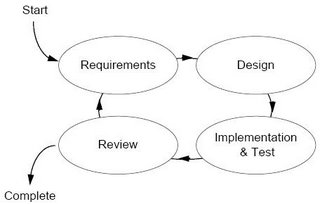requirements. Instead, development begins by specifying and implementing just part of the software, which can then be reviewed in order to identify further requirements. This process is then repeated, producing a new version of the software for each cycle of the model. Consider an iterative lifecycle model which consists of repeating the four phases in sequence, as illustrated by following figure.

· A Requirements phase, in which the requirements for the software are gathered and analyzed. Iteration should eventually result in a requirements phase which produces a complete and final specification of requirements.
· Design phase, in which a software solution to meet the requirements is designed. This may be a new design, or an extension of an earlier design.
· An Implementation and Test phase, when the software is coded, integrated and
tested.
· A Review phase, in which the software is evaluated, the current requirements are reviewed, and changes and additions to requirements proposed.
For each cycle of the model, a decision has to be made as to whether the software produced by the cycle will be discarded, or kept as a starting point for the next cycle (sometimes referred to as incremental prototyping). Eventually a point will be reached where the requirements are complete and the software can be delivered, or it becomes impossible to enhance the software as required, and a freash start has to be made.
The iterative lifecycle model can be likened to producing software by successive
approximation. Drawing an analogy with mathematical methods which use successive approximation to arrive at a final solution, the benefit of such methods depends on how rapidly they converge on a solution.
Continuing the analogy, successive approximation may never find a solution. The iterations may oscillate around a feasible solution or even diverge. The number of iterations required may become so large as to be unrealistic. We have all seen software developments which have made this mistake!
The key to successful use of an iterative software development lifecycle is rigorous validation of requirements, and verification (including testing) of each version of the software against those requirements within each cycle of the model. The first three phases of the example iterative model are in fact an abbreviated form a sequential V or waterfall lifecycle model. Each cycle of the model produces software which requires testing at the unit level, for software integration, for system integration and for acceptance. As the software evolves through successive cycles, tests have to be repeated and extended to verify each version of the software.

